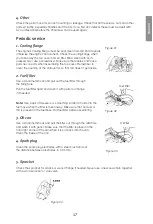
10
EN
G
LI
S
H
Chain oil
Idle screw
Low speed nozzle
High speed nozzle
5. As soon as the engine ignites the choke lever must be put into START position. See fig b
and pull/tug the start handle again to start the engine.
6. Warm up and keep the engine running by gasing the engine a little.
Warning! Make sure that the saw chain is not in contact with anything when the engine is
started. The saw chain starts to rotate directly when the motor starts.
Check the chain lubrication
Warning! The guide bar, saw chain and drive sprocket should always be assembled while
checking the chain lubrication. If you start without these being assembled you can be
injured by rotating parts or by the centrifugal clutch’s weights. It is very dangerous to start
the chain saw if all the parts are not mounted.
Start the engine and let it run on medium speed. Keep the guide bar with the saw chain close to
the ground or an object. If the chain lubrication is working a small amount of oil should spatter in
front of and under the guide bar.
Adjusting caburettor
The carburettor is carefully adjusted in the factory however it might need to be trimmed.
Before adjusting the carburettor you must always check that the air filter is whole and clean and
that the right quality fuel and oil mix are in the fuel can.
If you need to adjust the carburettor do so in the following way:
Note!
Guide bar and saw chain must always be assembled before adjusting the carburettor.
1. Shut the engine off and screw in (clockwise) both nozzles (H and L) completely. Do not
tighten, only until they stop. Then unscrew (anticlockwise) them.
H (high speed nozzle): 3/4± 3/8 revolution
L (low speed nozzle): 1½± ¼ revolution
2. Start the engine and warm it up on semi-gas.
3. Carefully turn the low speed nozzle (L) clockwise to a positon which gives the highest idle
revolution. Then turn the nozzle back ¼ revolution anticlockwise.
4. Turn the idle screw (T) anticlockwise and decrease the engine revolution until the saw chain
stops. Turn the idle screw (T) clockwise if the idle is too low.
5. Make a trial cut into a log and adjust the high speed nozzle (H) for strongest power, not for
the highest revolution. It should not die out. It should four-stroke.
Figure 11
Figure 12
Figure 13











































